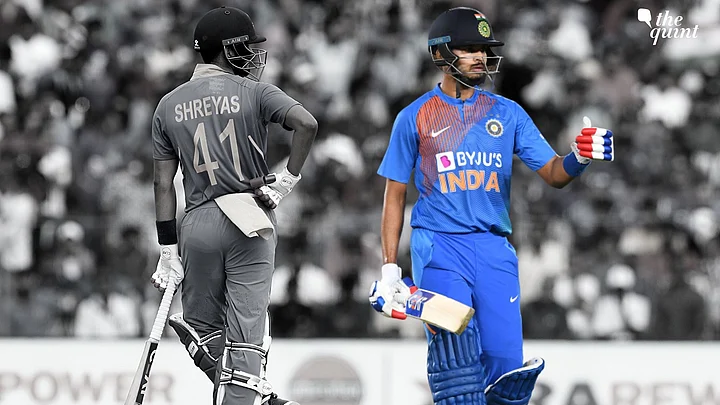As New Zealand fast bowler Hamish Bennett steamed in from around the wicket to cramp Shreyas Iyer for room. Iyer swiftly moved to his right, executed a nonchalant flick, and with the short boundary at fine-leg, the right-handed batsman notched up four valuable runs.
This, from the first T20I at Eden Park, was a sign of Iyer's capability to think on the go. on a ground where the dimensions are pretty unusual.
In the second T20I, again at Eden Park, Blair Tickner rushed in to target Iyer's fourth-stump with a back of a length delivery. Again, the Mumbaikar calmly moved to his left to create room on the off-side, and hoisted the pacer over long-off for a maximum.
The versatility of Iyer as a batsman is evident from these two extraordinary shots on two different days. But what’s also telling is the timing at which he chose to do something out of the ordinary in two run-chases which were as diverse as chalk and cheese.
On the first occasion, India needed 29 from three overs and Iyer made sure he stayed till the end, before the tie went down to the wire. On Sunday, India needed 28 from as many deliveries and Iyer was on a mission to show that he could give the pacers a whack — his lack of ability to do is a criticism that has often been thrown his way.
India, in the post-Dhoni era, do not like to leave run-chases till the very end.
They thrive on the Virat Kohli-formula of settling in, finding odd boundaries, running hard between wickets and taking on the opposition, at a time they aren't quite prepared for the onslaught. Kohli has embodied this approach for long, and of late, has found an able accomplice in Iyer.
A Worthy Number 4
“Virat Kohli is the perfect example when he goes out to bat, and the way he plans his innings. I learn a lot from him personally. I think that I have to stay not out and it really helps me grind through that middle period and, when the time comes, I take on the bowlers.”Shreyas Iyer, Indian Cricketer
“That’s how you plan your innings when you are chasing. At the back of your mind, I like to give myself some time and I also count the spinners’ overs, and gauge how many they will bowl,” Iyer said after his brilliant knock in the second T20I, a 33-ball 44, on Sunday.
Kohli's influence was glaringly evident in Iyer's efforts in the two run-chases —effortless batting coupled with brilliant execution. Off his first 14 balls, Iyer made just 18 runs in the first T20I. From there on, he raced to 58 in 29 balls, slamming 40 runs in the next 15 deliveries.
On Sunday, the approach was a touch more refined.
With the target within sight, Iyer took it upon himself to test the learning curve he has been going through. Against Australia at Bengaluru in the series decider, Kohli had allowed Iyer to go after the quick bowlers.
“Shreyas came up and asked me, ‘Should I attack?’ I said yes because the pressure was off us. Because of the (good) position (we were in), I wanted it to be a part of his learning, to take on their best bowlers. And his execution was outstanding.”Virat Kohli, Team India Captain
In the second T20I, with Kohli back in the hut and victory well within sight, Iyer didn’t need a second invitation. He dislodged Tickner for a thumping four and a six in the 16th over and followed it up with a towering six off Ish Sodhi in the next.
Although he was dismissed a ball later, the visitors were well on course to take a 2-0 lead in the five-match series.
India have been bullish in run-chases, but if there's something they have missed, it is composure and temperament from the middle-order. Once over-reliant on Kohli, India now have a back-up in Iyer — a plan that’s proving to be less permeable by the day.
More than a mere striker of the ball, Iyer has the ability to play according to different situations.
This was evident from his mature display as captain of Delhi Capitals in the IPL as well. In a team which had the likes of Rishabh Pant, Prithvi Shaw and Chris Morris in the last few seasons, Iyer's job was to anchor the innings and he did that with aplomb, from the middle.
Among batsmen at No 4 to No 6 position in the IPL in the last three seasons, only three players have a higher average than that of Iyer's 39.8 — MS Dhoni, AB de Villiers and Hardik Pandya, a trio worshipped for their finishing skills.
Iyer’s balls per boundary rate of 5.52 from this position is almost on par with Dinesh Karthik, an exemplary finisher, and better than that of Rohit Sharma, Ben Stokes, Kieron Pollard and MS Dhoni.
Since walking into the Indian side, Iyer has shown that his power game — for which he was initially under the radar as a teenager — never disappeared. Since 2019, Iyer has the most sixes by any Indian in T20 cricket — a stunning 67 maximums, which is the seventh-best among all T20 players in the world.
With a Kohli-like ability to switch between attack and defence besides excellent temperament and game awareness in run-chases, Iyer is quickly emerging as an able No 4 — a position that India has struggled to fill in of late, including the 2019 World Cup.
(At The Quint, we question everything. Play an active role in shaping our journalism by becoming a member today.)
